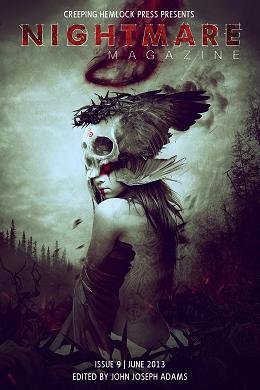 Nightmare #9, June 2013
Nightmare #9, June 2013
“Fishwife” by Carrie Vaughn
“The House on Cobb Street” by Lynda Rucker
Reviewed by Lillian Csernica
It’s not easy to get through an entire short story without naming a single character, but Carrie Vaughn does so in “Fishwife.” The main character is the wife of one of the fishermen who make up the population of the poverty-stricken village where the story is set. She is referred to only as “she,” which made it difficult for me to connect with her and feel much reader sympathy. The key problem in the story is the lack of fish. Apparently this lack of fish has been going on for a very long time, leading me to wonder what the locals have been living on because they sell what few fish they catch. “Fishwife” has a beginning, a middle, and an end, but it lacks conflict, character development, and suspense. The heroine takes action, and some of those actions are pretty drastic, but the tone remains too low-key. None of the other villagers so much as comments. There is no dialogue in the story at all, only the unnamed heroine’s internal narrative. What passes for the antagonist is the village priest. He meets an unhappy end, but even that is kept offstage. The pace drags, the solution to the villagers’ problem is just handed to them, and the ending comes as no real surprise. At Carrie Vaughn’s website, “Fishwife” is summarized as “A damp foray into Lovecraftian horror.” Sorry, no. “Fishwife” totally lacks the creeping sense of dread, the wrongness, that make “The Dunwich Horror” and “The Shadow Over Innsmouth” such classics.
Lynda Rucker‘s “The House on Cobb Street” is the first horror story I’ve read in a while that really did give me the creeps. I got so caught up in reading it that I forgot to make review notes. The central idea of the plot is whether or not Vivian Crane ever really existed due to the conflicting memories and comments of her college students and the few people who knew her personally. Vivian herself call her life, marriage, and memories into question as the bizarre nature of the House itself exerts its influence. Her husband Chris is the first to suffer its full effects. The story is told in epistolary style, including excerpts from blogs, newspaper articles, testimony of people involved, and Vivian’s own narrative. I found some of the speculation about Chris to be a bit redundant. The more I got involved in Vivian’s own narrative, the more I found the other “clippings” to be somewhat distracting, but all the parts do combine to create an unsettling atmosphere, a definite need to read with the lights on, and a lingering sense of the creeps. In “The House on Cobb Street,” I found what I most enjoy when I read the weird tales of Ambrose Bierce.
Lillian Csernica is a returning reviewer, having written “The Penny Dreadful Reader” short horror column for the print version of Tangent back in the ‘90s. Her fiction has appeared in Weird Tales, The Year’s Best Horror XX and XXI, Midnight Movie Creature Features, Vol. 2, and Tales to Terrify.